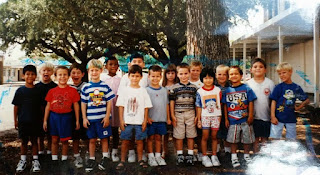I forgot to mention last time another piece of bad news. Martin Villareal (DHS '66) passed away recently. Here is an obituary. Thank you Scotty Hightower Bass (DHS '66) and Marsha Bauman Shaw (DHS '68) for relaying the information.
I don't recall who brought this to my attention, but another resident of old Sugar Land, Bertha Presas Cantu died recently.
My best to the Villareal and Cantus families.
I got help from Marsha Krause Smith (DHS '68), Peggy Norman, and Debbie Duggan Gamble herself with an identification of her sister Pam Duggan Gray, who is pictured in this photo. Thanks to you all. Debbie said Pam was the Vikette mascot that year.
I want to give a big thank you to Sadie Williams, Jimmy Williams, and Charles Court for identifying members of the Missouri City boys basketball team, which I got from Lee Elkins LeGrand and posted last time. Here's the photo again.
Here are the ids:
Lawrence Elkins, Coach
17 Glenn Jochec
21 Bobby Williams
20 Bobby Davis
18 Alfred Renfrow
13 Charles Court
19 Andrew George
16 Louis Rychlick
12 Donald Jordy
14 Donald Cothern
15 Eugene Dinges
Sadie also pointed out that the director of the 1941 Mustang Marching Band was Leonard Scarcella's father. I knew he was the school's band director, but I didn't know which years. Mother has told me many times that she remembers Leonard was the band's mascot for a few years. He wore a white suit to football games -- I wish we had photos of that!
Finally, I want to post info on some upcoming events that may interest you.



































